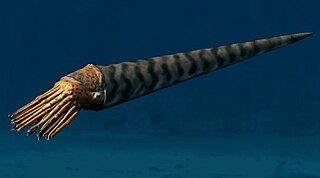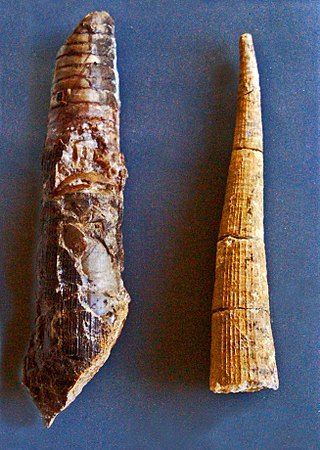Related Research Articles

Orthoceratidae is an extinct family of actively mobile carnivorous cephalopods, subclass Nautiloidea, that lived in what would be North America, Europe, Asia, Africa, and Australia from the Ordovician through Triassic from 490—203.7 mya, existing for approximately 286.4 million years.

The Ascocerida are comparatively small, bizarre Orthoceratoids known only from Ordovician and Silurian sediments in Europe and North America, uniquely characterized by a deciduous conch consisting of a longiconic juvenile portion and an inflated breviconic adult portion that separate sometime in maturity.

Lamellorthoceratidae is a family of fossil orthoceratoids in the Orthocerida, defined by Curt Teichert in 1961. The lamellorthoceratids are placed in the superfamily Orthocerataceae in the Treatise on Invertebrate Paleontology.

Slender Oncoceratidae are those in the family Oncoceratidae, which have slender, commonly curved, shells. Some like Oocerina are gently curved, almost straight, and with only slight expansion. Others like Dunleithoceras are strongly curved with a more notable rate of expansion. Inclusion in this somewhat arbitrary category is based on illustrations in the Treatise Part K, 1964.
The Brevicoceratidae is a family of oncocerids that contains genera characterized by exogastric gyrocones, brevicones, and torticones. that tend to develop vestigial actinosiphonate deposits and subtriangular transverse sections. The Brevicoceratidae are derived from Oonoceras (Oncoceratidae) and range from the mid-Silurian to the Upper Devonian.

The Trocholitidae are Tarphycerida with whorls in close contact as with the Tarphyceratidae, but in which the siphuncle, similar in structure, becomes dorsal. The Trocholitidae are derived from the Tarphyceratidae, perhaps from different tarphyceratids.
Spyroceras is a genus of pseudorthocerids from the Devonian of North America and Europe, defined by Alpheus Hyatt in 1884. Pseudorthocerids are a kind of orthocertaoid, a taxonomic group within the Nautiloidea. Specifically Spyroceras belongs to the pseudorthocerid family, Spyroceratidae.

Kionoceras is an extinct nautiloid cephalopod genus included in the orthocerid family Kionoceratidae with scattered worldwide distribution from the Middle Ordovician to the Lower Permian. Kionoceratids are orthocerids with prominent longitudinal ornamentation on their shells, sometimes augmented by secondary transverse ornamentation. Orthocerids are, of course, prehistoric nautiloides with generally straight and elongate shells, mostly with central or subcentral siphuncles.

Geisonoceratidae is an extinct family of orthoceroid cephalopods endemic to what would be Asia, Europe, and North America from the Middle Ordovician to the Middle Devonian living from about 470—380 mya, existing for approximately 90 million years. With the possible addition of an Early Cretaceous orthocerid from the western Caucasus the range of this group increases dramatically to some 350 million years, thus making it one of the longest lived families of the Nautiloidea.

Dawsonoceratidae is an extinct family of orthoconic nautiloid cephalopods that lived in what would be North America and Europe from the Late Ordovician through the Middle Devonian from about 480–390 mya, existing for approximately 90 million years.
Protobactrites is an extinct nautiloid cephalopod belonging to the Orthoceratoidea that lived in what would be Europe and Asia during the Ordovician and Silurian from 466–421.3 mya, existing for approximately 44.7 million years.

The Phragmoceratidae is a family of extinct nautiloid cephalopods from the Order Discosorida that lived during the latter part of the Silurian.
Pentameroceras is a straight to slightly exogastric breviconic oncocerid from the middle Silurian of North America and Europe belonging to the Trimeroceratidae.
Parakionoceras is an extinct nautiloid that lived during the Silurian and Devonian in what is now Europe; included in the orthoceratoid family Kionoceratidae in the Treatise part K, 1964 but removed to the Arionoceratidae in Kröger 2008.
Sactorthceras is an orthoceratoid genus known from the Middle Ordovician of eastern North America (NY), Norway and Korea and is the type genus of the Sactorthoceratidae.
Cyrtogomphoceras is a genus of nautiloid cephalopods, recognized by its large breviconic shell with a notable endogastric curvature. The shell is fusiform in profile, reaching maximum width at or near the base of body chamber, which narrows toward the aperture. The siphuncle is large and slightly removed from the ventral side, that with the concave longitudinal profile. Siphuncle segments are short, as are chambers; septal necks recurved, connecting rings thick, bullettes at the apical end of the rings swollen. Cameral deposits are lacking.
Hercocyrtoceras is a middle Silurian oncocerid found in Nova Scotia and Quebec. Shells are depressed, irregularly annulated cyrtocones with V-shaped hyponomic sinuses, ornamented by longitudinal and transverse ridges. Position and structure of the siphuncle were unknown as of 1964.
Danaoceras is a nautiloid cephalopod from the middle Silurian of central Europe included in the oncoceroid family Polyelasmoceratidae. Similar specimens from the middle Devonian of North America may belong.
Cyrtocycloceras is a genus of orthocerids from the Middle Silurian of Europe included in the Paraphragmitidae.
Gaspocyrtoceras is a genus of orthocerids included in the Paraphragmitidae. Its fossils are limited to North America and have been found in Wisconsin and Quebec.
References
- Walter C. Sweet, 1964. Nautiloidea -Orthocerida. Treatise on Invertebrate Paleontology, Part K. Geological Society of America.
- Calocyrtoceras, Fossilworks, PaleoDB gateway